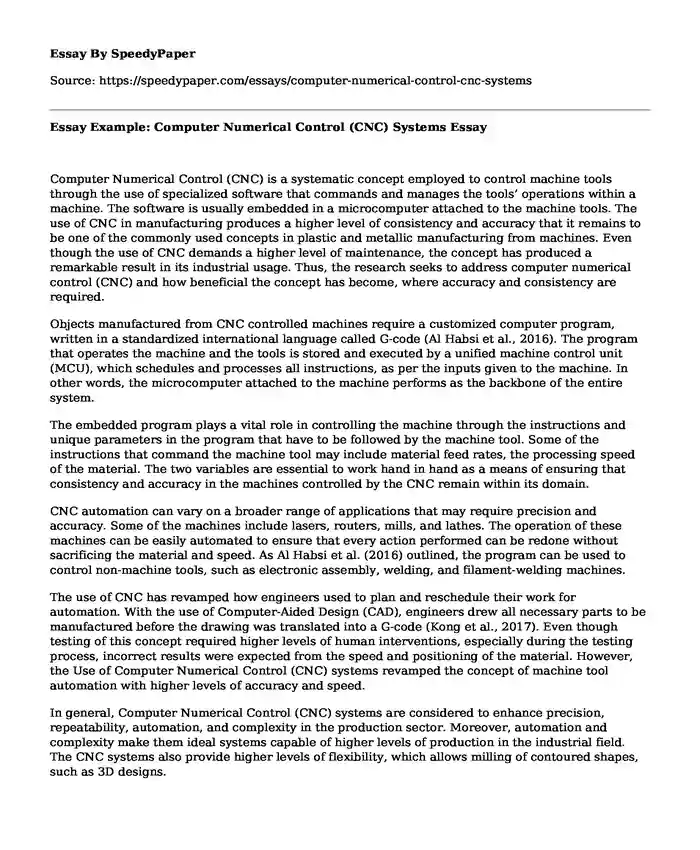
| Type of paper: | Essay |
| Categories: | Engineering Software Information systems |
| Pages: | 3 |
| Wordcount: | 650 words |
Computer Numerical Control (CNC) is a systematic concept employed to control machine tools through the use of specialized software that commands and manages the tools’ operations within a machine. The software is usually embedded in a microcomputer attached to the machine tools. The use of CNC in manufacturing produces a higher level of consistency and accuracy that it remains to be one of the commonly used concepts in plastic and metallic manufacturing from machines. Even though the use of CNC demands a higher level of maintenance, the concept has produced a remarkable result in its industrial usage. Thus, the research seeks to address computer numerical control (CNC) and how beneficial the concept has become, where accuracy and consistency are required.
Objects manufactured from CNC controlled machines require a customized computer program, written in a standardized international language called G-code (Al Habsi et al., 2016). The program that operates the machine and the tools is stored and executed by a unified machine control unit (MCU), which schedules and processes all instructions, as per the inputs given to the machine. In other words, the microcomputer attached to the machine performs as the backbone of the entire system.
The embedded program plays a vital role in controlling the machine through the instructions and unique parameters in the program that have to be followed by the machine tool. Some of the instructions that command the machine tool may include material feed rates, the processing speed of the material. The two variables are essential to work hand in hand as a means of ensuring that consistency and accuracy in the machines controlled by the CNC remain within its domain.
CNC automation can vary on a broader range of applications that may require precision and accuracy. Some of the machines include lasers, routers, mills, and lathes. The operation of these machines can be easily automated to ensure that every action performed can be redone without sacrificing the material and speed. As Al Habsi et al. (2016) outlined, the program can be used to control non-machine tools, such as electronic assembly, welding, and filament-welding machines.
The use of CNC has revamped how engineers used to plan and reschedule their work for automation. With the use of Computer-Aided Design (CAD), engineers drew all necessary parts to be manufactured before the drawing was translated into a G-code (Kong et al., 2017). Even though testing of this concept required higher levels of human interventions, especially during the testing process, incorrect results were expected from the speed and positioning of the material. However, the Use of Computer Numerical Control (CNC) systems revamped the concept of machine tool automation with higher levels of accuracy and speed.
In general, Computer Numerical Control (CNC) systems are considered to enhance precision, repeatability, automation, and complexity in the production sector. Moreover, automation and complexity make them ideal systems capable of higher levels of production in the industrial field. The CNC systems also provide higher levels of flexibility, which allows milling of contoured shapes, such as 3D designs.
Despite the benefits presented by the automation of the system under the CNC systems, there is a higher price incurred during the implementation window. CNC requires higher maintenance levels, which may push the organization to hire a dedicated independent programmer. On the contrary, this system is not ideal for small-scale firms that do not have the resources and capacity to implement or maintain the CNC systems.
References
Al Habsi, G. R. K. H., & Rameshkumar, G. R. (2016). Design and Fabrication of 3-Axis Computer Numerical Control (CNC) Laser Cutter. International Journal of Multidisciplinary Sciences and Engineering, 7(5), 7-16. https://pdfs.semanticscholar.org/d3e6/3f75823e95bf9a4fcffbb373842b5a313dfc.pdf
Kong, X., Tang, L., Ye, Q., Huang, W., & Li, J. (2017). Are computer numerical control (CNC)-manufactured patient-specific metal templates available for posterior thoracic pedicle screw insertion? Feasibility and accuracy evaluation. European Spine Journal, 26(11), 2927-2933.doi:10.1097/BRS.0b013e3181d1021a
Cite this page
Essay Example: Computer Numerical Control (CNC) Systems. (2023, Nov 28). Retrieved from https://speedypaper.com/essays/computer-numerical-control-cnc-systems
Request Removal
If you are the original author of this essay and no longer wish to have it published on the SpeedyPaper website, please click below to request its removal:
- Beijing Hutongs Historical Heritage, Essay Example for Free Download
- Essay Sample on Artificial Intelligence Future and It Perils
- Paper Sample. Technology Issues in Organizations
- Essay Sample on New Conservatism: Republican Shift from 1960s-1980s
- Essay on Autonomous Navigation: Design & Research of Multi-Machine Autonomy
- Paper Example: Corporate-Level Strategy
- Free Essay Sample on Digital Transformation
Popular categories




